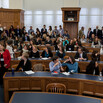Students Develop Tools for Tribal Land Reacquisition
In early December 2015, three Yale Law School students and one Yale Forestry student visited the Flathead Reservation in Montana—home to the Confederated Salish and Kootenai Tribes (CSKT). The trip was a part of an Environmental Protection Clinic project called “Restoring and Consolidating Tribal Land Ownership through Probate Reform.” During the 2015 fall semester, Lynsey Gaudioso ’17, Katie Jones ’16, Chelsea Lane-Miller ’17, and Paul Burow FES ’16 worked with CSKT to develop a tribal probate code. The code will help the Tribes mitigate the impacts of earlier allotment policies by consolidating fractionated trust interests and increasing the reservation land base.
The trip was laid a critical foundation for continuing the project. Students presented their work to the CSKT Tribal Council and discussed next steps with CSKT’s Lands and Legal Departments. Students also met with other important tribal stakeholders, including a tribal judge who presides over probate cases, the CSKT Public Defenders Office, and the Salish Pend d’Oreille Culture Committee. Each of these people provided essential insight into how CSKT’s probate process currently works and which reforms will be the most effective and culturally appropriate. In addition, students toured reservation properties affected by fractionation as well as the Seli’š Ksanka Qlispe’ Dam (formerly known as the Kerr Dam) located on the lower Flathead River. The Tribes recently acquired the dam from PPL Montana in September 2015.
The trip was supported by the Environmental Protection Clinic and by the Deborah L. Rhode Fund.


